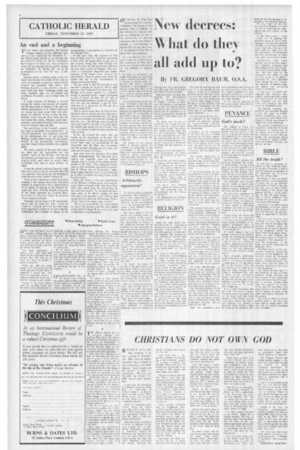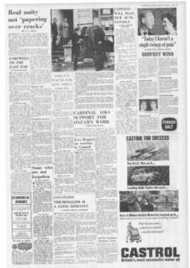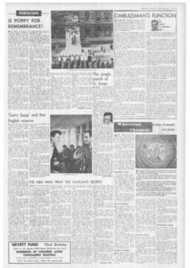Page 4, 12th November 1965
Page 4

Report an error
Noticed an error on this page?If you've noticed an error in this article please click here to report it.
Tags
Share
Related articles
Churches Groh' More Alike
Undergrads To Join Forces?
New Censorship Rules
Fr Baum To Seek Laicisation
College Staff Resigns In Ban Protest
New decrees: What do they all add up to?
By FR. GREGORY BAUM, U.S.A.
theology may have conversation and fellowship with the students and other university faculties.
THE DECREE ON THE RENEWAL OF RELIGIOUS LIFE is modestly written: its content however is dynamite. All religious congregations are to seek the renewal recommended by the Council, In this process all the members of religious congregations should be consulted. Experiments may be PC rmitted.
The guide lines for the renewal are the Gospel of Jesus Christ and the original inspiration of the founder. This means that neither present canon law nor the constitutions inherited by the congregations nor even the statutes given by the founder are to he considered as normative: normative is the Gospel of Christ and the founder's inspiration.
Religious must not expect detailed programmes of reform from the Council or from the Holy See.
Conditions vary from country to country. On the basis of the decree, religious are to examine their lives, consult with one another, and through their chapters or other legitimate organs formulate the way in which they must follow Christ today in fidelity to the Gospel and the spirit of their foundation.
The decree gives religious orders a basis on which to insist that their . proposals will be acknowledged by the Roman Congregation.
The declaration on Christian education I have not yet read.
RELIGION
Good in it?
ONL OF 'UHL mos-T REMARKABLE ecclesiastical documents ever published is the conciliar declaration on the Christian approach to non-Christian religions. No Church has ever pronounced itself on other religions.. Future generations, more at home in religious pluralism than we are, may well look hack to this declaration as the great achievement of Vatican II,
In harmony with other conciliar documents acknowledging the mercy of God at work in the world, beyond the boun• daries of the Church. the present declaration recognises God's saving action in the great religions of the world. despite the ambiguities and deficiencies that may be associated with them.
The declaration does not present a theological explanation of this. It simply calls upon Christians to respect other religions as something sacred and to engage in dialogue with them.
he declaration clearly asserts that God has revealed the fullness of his mercy, and the way of salvation, in his Son Jesus Christ. Al the same time very little is said relating the Church's dialogue to her mission to preach the Gospel. The time for synthesis has not come. It is not possible at this point to present in a perfectly coherent picture the role of the Church in the world of men, as it emerges from the declaration on non-Christian religions, from the decree on the missions, and from the constitution on the Church in the modern world. There are as yet many unresolved problems.
The declaration on the Christian approach to the religions contains the important passage on Jewish-Christian relations. Pope Paul was especially moved by this passage.
Conscious of the weakening of the final text. as a minimal concession to the radical opposition of the Near-Eastern bishops, the Pope warmly mentioned the Jews in his speech at the occaskin : the .lews are for us, he said, "not objects of reprobation or distrust, but of respect, love and hope".
The present declaration removes the ambiguities which have been the cause of the antiJewish tendency in much of Christian preaching over the centuries.
It clearly announces the saving action of God in Israel prior to the corning of Christ, it explains that all the events of our salvation took place within the Jewish people (Jesus and his disciples were as Jewish as his adversaries). and thirdly it clarifies that the history of the Jews after the coming of Christ is not under the shadow of divine reprobation, but on the contrary, in the sun of the perduring promises of God whose gifts arc irrevocable.
The present declaration outlines a practical programme of Jewish-Christian friendship, It rejects all forms of antisemitism, it exhorts teachers of the Christian Ciii;,pal tel he faithful to the truth. it encourages dialogue and cooperation between Christians and Jews. more than that, it acknowledges the common spiritual patrimony between The Church and the Synagogue.
One may he a little sad that the declaration is not quite as strong as the draft of last year, but one will have to admit that
this extraordinary conciliar document clo,c, an entire phase, a most unhappy one, of JewishChristian relations and opens a new era in the history of the Church in respect to her attitude and approach to the Jewish people. For this we are grateful.
IN 1HE MEANTIME the conciliar work proceeds. The Commissions are meeting daily to revise the documents not yet published. Ilse majority of the bishops however, those not con sleeted with a drafting commission, have really nothing to do. Sonic have gone on holidays.
The Secretary-General of the Council announced some time ago that during the periods of recess the espisecipal conferences were to meet and discuss various suhjects submitted to them. This programme. however, did not come off too well.
Only two documents have been submitted to the bishops so far. and since there were only a few copies available for each episcopal conference, a responsible discussion of the matter was not really eossible.
To this day the planning of this extra-conciliar discussion remains quite obscure.
PENANCE
God's work?
The subjects on which two documents were proposed to the bishops were the reform of the laws on fast and abstinence and the renewal of the ordering of indulgences. What ‘A S astounding about the two documents was that their theological understanding of the penitential life of the Church was wholly determined by the tradition of the manuals: the conciliar renewal of theology had had no effect on their composition.
Speaking about penance the document presented the dttalistic understanding of man which many of us had regarded as a thing of the past. Man is indeed divided. but the morally significant division is not between the higher and lower faculties, but between generosity and egotism.
The document still regarded penance mainly as man's work and not. in accordance with the biblical teaching. principally as the work of God in man.
The documents presented the Church's treasury of merits in almost material terms, as a kind of heavenly bank. and hence regarded the Church's application of these merits to individual Christians tin form of an indulgence) as an act of jurisdiction.
Judging from the responsible accounts which have appeared in the press, the proposed documents hardly presented an acceptable theological basis on which to discuss the renewal of C twitch legislation.
It would appear that the bishops were not even asked to discuss the theological teaching of the documents. They were simply to vote on a number of questions, appended to the documents. relating to the new legislation on fast and abstinence and to the new scheme of indulgences, Many episcopal conferences simply refused to express themselves in this fashion on matters as important as the penitential life of the Church. They felt that there is a real need to rethink the entire mystery of the Church's penitential life, with its focus in the sacramental liturgy. and that it is only in this context that the issue of indulgences and the days of fast and abstinence call be reasoeably brought up.
It is a little frightening that the curial commission responsible for these two documents was not in touch with the living theology of the Church. According to press reports. the American hierarchy was content to deal with these matters simply by voting on the questions pro posed in the two documents regarding a few practical changes.
We may hope that one day the Synod of Bishops will have the task of renewing the pentitential life and practice of the Church.
If the Synod finds a more suitable way of applying the powerful prayer of the Church, relying on the work of Christ in his body, to the total reconciliation of individual christians with God, then we might even see the abolishment of indulgences and the introduction of more meaningful pen i ten tial worship,
DURING THE LAST WEEK, one of the most important dogmatic statements was finally approved by the Council: the constitution on divine revelation. The first draft of this document, then called "on the two-fold source 01 revelation", provoked • the first significant crisis during the first cession. The majority of bishops objected against, the two-source theory of revelation.
In their eyes, this theory presupposed that revelation consisted of true propositions about God made known by Him, and that Tradition • was not only wider than Scripture but even relatively independent of it.
The bishops. moreover, objected to the document because it was not open to modern biblical scholarship. The crisis was overcome when Pope John created a mixed commission to rewrite the entire document.
The present constitution is a magnificent statement on divine revelation. Is transmission in the Church. and on the role of the Scriptures in the Christian people. The constitution reflects the advance of biblical scholarship and Catholic theology over the last decade.
BIBLE
All the truth?
t will h n thefuturea profound influence
a t o c thought. Personally I believe that the influence on theology of this document will be greater than that of any other.
Revelation is here no longer understood as a communication of truths, but as the self-communication of God in the person and work of Jesus Christ. The totality of the words and gestures of Christ. of his teaching. his life, his entire personality, is divine revelation. This doctrine will give rise to a new theological. epistomology.
According to the press reports the document underwent a good deal of pressure in the commission. The minority was unrelenting in its opposition to the final draTfL text now mentions that Tradition is wider than Scripture, but only in the sense that ultimate certitude about the meaning of all that is revealed in the Scriptures cannot be drawn from the Scriptures themselves: for this certitude. the life of the Church, or Tradition. is required. (This statement recalls the declaration of the Faith and Order Conference at Montreal, I963.1
The final version of the constitution. moreover. defends the inerrancy of the Scriptures, but the truth which the Scriptures contain without error, is qualified by a subordinate clause: the truth which God the author of salvation intended to put down in the Scriptures. •
This leaves the door open for the admission of error in many historical details. Similarly the final version of the constitution asserts the historicity of the gospels in general. leaving quite open the question of literary forms and the possibility that many things in the life of Christ did not happen precisely in the order and manner described in the gospels.
The work at Rome is almost finished. God in his mercy has been with his people again. The real task of renewal continues now—at home.
blog comments powered by Disqus











